


I’ve tested out Trace Pixel Art on a couple of old icons I made a thousand years ago. It’s meant specifically for tracing pixel-based art, like we used to have to draw back in the ’80s and ’90s. This is a fairly recent addition to Inkscape, and it probably isn’t an option you’ll use that frequently. So don’t grab an image from Google, Pinterest, or any other website and trace it. It’s up to the creator of that image what they’ll allow you to do with it. Even in this sample image, while the lines look relatively smooth in the JPG on the left, you can see how many points it’s created in the trace on the right.Īnd my usual note about tracing: remember, if you’re tracing an image someone else made, you need their permission. Your best bet for clean tracing is to bring in the largest possible image, with as little noise or pixellation as possible. The tracing algorithm looks for the contrast between light and dark, and creates points and lines along those contrasted areas.

Your best tracing will come from black lines and shapes on a white background. So again, make sure you have it just how you want it before you convert it, and tuck a pre-conversion copy away in case you decide later that you want a different size or style of stroke.Įven though Trace Bitmap specifies a bitmap, you can use any raster image – BMP, JPG, PNG, GIF. When you apply Stroke to Path, you turn that stroke into a fully editable set of points and lines. But while it’s editable as a stroke, it isn’t a true vector object. You can use the Fill and Stroke window (Object > Fill and Stroke) to change the color or width of a stroke around any shape you can even change it from a solid stroke to a dotted or dashed line. When you put a stroke around an object, it has the same kind of editable flexibility that typed text does. (And remember, it’s always a good idea to make a copy of your text before you start to mess with it. But once you want to manipulate those letters, you’ll want them in true vector format so you can really mess with the points and lines. You can resize, change fonts, fix spelling, all that good stuff. I most frequently use it on text – when you type it out, it can be manipulated as a font. This takes an object and transforms it into a vector shape made up of points and lines. So let’s take a look at the Inkscape equivalents, so you don’t have to go through the years of workarounds that I did.įirst in the list is Object to Path.

Everything in there is super handy, and I use these things all the time. These days, however, I keep that Pathfinder window in one of the cherished spots in my most-used-items toolbar. I didn’t understand them, I never knew which one to pick, and I found other ways to achieve the results I wanted. And I’ll readily admit here, I didn’t use Illustrator’s Pathfinder options for years. So today we’re going to go through the menu to take a look at what everything does.Ĭoming to Inkscape as someone who’s been using Illustrator for over a decade, a lot of the features are quite similar. The Path menu contains a ton of really, really handy features and functions when it comes to manipulating your fonts and other shapes and objects.
Inkscape tutorials path exclusion full#
Since I’m digging deeper into learning Inkscape so that I can share some how-to posts with you all, I figured I’d take a walk through the menu I’m sending you to the most – especially because it’s often full of the most confusing things.


 0 kommentar(er)
0 kommentar(er)
